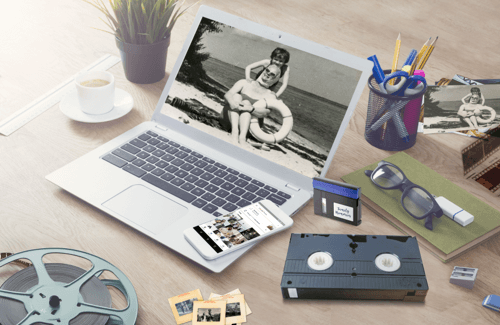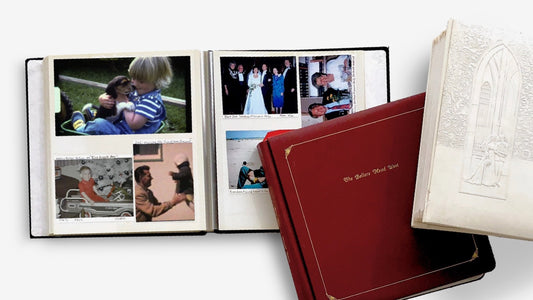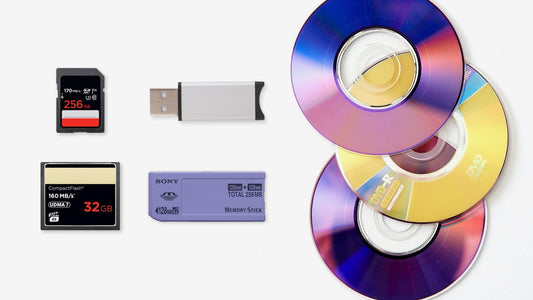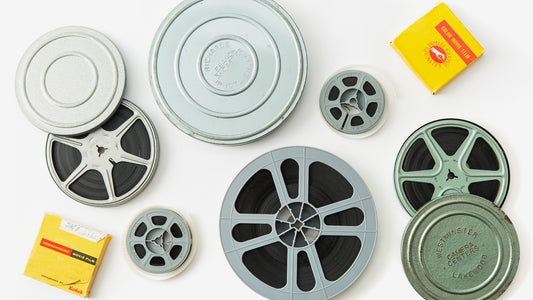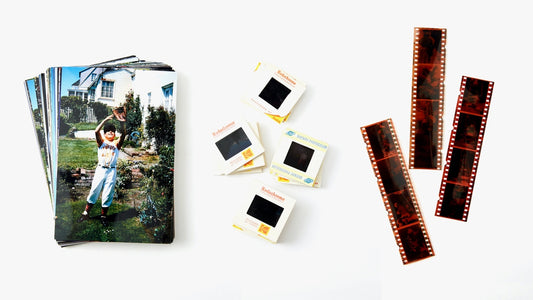Your family’s story is captured on those small, rectangular MiniDV tapes stored in your closet. They hold the sights and sounds of moments that deserve to be shared and relived, not forgotten in a box. Preserving these videos is about more than just saving old files; it’s about connecting generations. It’s about showing your kids what you were like on your wedding day or letting them hear their grandparents' voices with perfect clarity. To do that, you need to move those memories from an outdated format into one that’s easy to watch and share. This guide will show you how to do just that, step by step.
Key Takeaways
- Recognize the Quality You're Preserving: MiniDV tapes hold high-quality digital video that's much sharper and clearer than older analog formats. A proper transfer preserves this original quality, ensuring your digitized home movies look just as good as the day they were filmed.
- Decide on Your Transfer Method: For the best DIY results, you'll need a working camcorder and a FireWire connection to create a direct digital copy. If sourcing old equipment sounds like a hassle, a professional service offers a simple, worry-free way to get high-quality results.
- Create a Smart Backup System: Once your videos are digitized, protect them from being lost by following the 3-2-1 rule: keep three copies of your files on two different types of storage (like an external drive and the cloud), with one of those copies stored off-site.
What Is a MiniDV Tape?
If you were filming home movies in the late '90s or early 2000s, you probably remember MiniDV tapes. These compact cassettes were a game-changer, offering a huge leap in quality over the bulky VHS tapes of the past. They represented a pivotal moment in home video technology, bridging the gap between analog formats and the purely digital, file-based cameras we use today. Essentially, a MiniDV tape stores video and audio as digital information on a strip of magnetic tape, packing impressive quality into a tiny package.
This digital format is what made them so special. Unlike their analog predecessors, MiniDV tapes captured crisper images and clearer sound, making them a favorite for families and even aspiring filmmakers. Because the information was already digital, it made the process of transferring videos to a computer much more direct. If you've found a box of these little tapes, you're holding onto some high-quality memories. The next step is ensuring they're preserved, and a professional video transfer can help bring those moments into the modern age for easy sharing and viewing.
Key Physical Features
You can spot a MiniDV tape by its distinctively small, rectangular shape. They are incredibly compact—about 20% the size of a standard VHS tape—which is what made the camcorders that used them so portable and popular. Measuring just about 2.5 by 2 inches, they could easily fit in the palm of your hand. This small form factor was a major selling point, allowing people to carry their video cameras everywhere, from birthday parties to family vacations, without the hassle of lugging around heavy equipment. Their size is a great first clue when you're sorting through old home movies.
How They Record Digital Video
The "DV" in MiniDV stands for Digital Video, and that's the key to their magic. Introduced in 1995 by a group of leading tech companies like Sony and Panasonic, the DV format was designed to record digital data directly onto magnetic tape. This was a revolutionary concept for consumer video. Instead of capturing fuzzy analog signals like VHS, MiniDV camcorders recorded video and audio as ones and zeros. This process preserved the original quality of the recording far better than older methods, resulting in a much sharper and more stable picture when you played it back.
Why They Beat VHS in Quality
The difference in quality between MiniDV and older formats like VHS or Hi8 is night and day. MiniDV tapes offered significantly better video resolution, which means the picture was sharper, the colors were more vibrant, and you didn't get that characteristic fuzziness of analog tapes. The audio was a huge step up, too. MiniDV recorded uncompressed, CD-quality sound, so every laugh, conversation, and background noise was captured with incredible clarity. This move from analog to digital recording was a major milestone, giving families the power to create home movies that looked and sounded more professional than ever before.
How MiniDV Technology Works
MiniDV tapes represented a huge leap forward in home video technology. Before them, most of us were using bulky analog tapes like VHS or Hi8, which were prone to quality loss over time. MiniDV changed the game by recording video and audio digitally onto a compact cassette. This meant the video quality was sharper, the sound was clearer, and the tapes themselves were much smaller and easier to carry around.
Think of it as the bridge between the old analog world and the fully digital one we live in now. The DV (Digital Video) format) packed a surprising amount of high-quality information onto that tiny tape, which is why the footage still looks impressive today. Unlike analog formats that recorded video as a continuous signal, MiniDV recorded it as digital data—a series of ones and zeros. This process preserved the original quality much more effectively, preventing the fuzzy degradation you see on old VHS tapes after multiple viewings. It’s this digital foundation that makes a high-quality video transfer possible, allowing you to preserve those memories exactly as they were recorded.
Storage Capacity and Recording Time
One of the most practical features of MiniDV tapes was their recording time. A standard tape could hold about 60 minutes of video in Standard Play (SP) mode or 90 minutes in Long Play (LP) mode. While LP mode gave you more time, it did so by compressing the data more, which could sometimes lead to minor quality issues during playback. For most people, 60 minutes was the sweet spot—plenty of time to capture a birthday party, a school play, or a family vacation without having to constantly swap out tapes. This capacity, packed into such a small cassette, made MiniDV camcorders the go-to choice for capturing life’s moments on the fly.
Video and Audio Quality
This is where MiniDV really shined. The video quality was a significant step up from older consumer formats like VHS and Video8. It delivered a sharper, more vibrant picture that was much closer to what you’d see on broadcast television at the time. But the audio was just as impressive. MiniDV tapes recorded uncompressed, CD-quality sound, which was a world away from the often muffled, hissy audio of analog tapes. When you watch your old MiniDV footage, you’ll notice that the voices and background sounds are incredibly clear. This combination of great video and audio is why these memories are so worth preserving.
Who Used MiniDV Tapes?
MiniDV tapes became incredibly popular in the late 1990s and early 2000s, serving a wide range of users. For families, they were the perfect tool for documenting everything from a baby’s first steps to graduation day. The compact size of the camcorders made them easy to bring anywhere. At the same time, the format’s high quality attracted semi-professionals and aspiring filmmakers. Independent filmmakers, wedding videographers, and journalists embraced MiniDV because it offered near-professional results without the professional price tag. It truly democratized digital video, putting high-quality storytelling tools into the hands of everyday people for the first time.
What Equipment Do You Need?
Alright, let's talk about the gear you'll need to bring your MiniDV memories into the digital age. Tackling this project yourself can be incredibly rewarding, but it does require gathering some specific, and often older, tech. Think of it like a fun tech treasure hunt with a priceless reward at the end: your preserved family videos. The process boils down to three key components: a device to play your tapes, the right cables to connect it to your computer, and software to capture the video footage.
The main goal is to create a clean, direct path for the digital data to travel from your tape to your computer. Since MiniDV tapes are already digital, a proper setup ensures you’re making a perfect copy, preserving the exact quality your camcorder originally captured. Getting this right is the most important part of the DIY process. It prevents the quality loss that can happen with other methods, like recording a screen.
Of course, sourcing old electronics isn't for everyone. If you'd rather skip the hunt for FireWire cables and compatible camcorders, remember that professional video transfer services have all of this specialized equipment ready to go. They handle the technical side so you can just enjoy the memories. But if you're ready for a satisfying project and want to manage the process yourself, here’s a breakdown of exactly what to look for.
Finding a Compatible Camcorder or Player
First things first: you need a device that can play your MiniDV tapes. The best-case scenario is that you still have the original camcorder you used to record the footage. If not, your mission is to find a compatible MiniDV camcorder or playback deck.
When you're searching, the most important feature to look for is a FireWire port, which is sometimes labeled as i.LINK or IEEE 1394. This port is the key to a high-quality digital transfer. Many older camcorders have this feature, and they often pop up on second-hand marketplaces. Make sure any player you consider is in good working condition, as a faulty device can potentially damage your precious tapes.
Connecting Your Gear: Cables and Ports
Once you have a player, the next step is to connect it to your computer. The best way to do this is with a FireWire cable. Because MiniDV is already a digital format, a FireWire connection allows for a direct, lossless transfer of the video data. It’s like copying a file from one drive to another—you get an exact replica without any degradation in quality.
The main challenge here is that most modern computers don't come with FireWire ports. But don't worry, you have options! You can use a FireWire-to-USB or FireWire-to-Thunderbolt adapter to bridge the gap. For desktop users, another great solution is to install an inexpensive PCIe FireWire card directly into your computer.
Software and Hardware for Transfers
With your hardware connected, you’ll need software to tell your computer how to capture and save the incoming video stream. Some older video editing programs, like early versions of iMovie or Windows Movie Maker, had this function built-in. However, using dedicated transfer software can often give you more control and better results.
Programs like DVRescue are designed specifically for this purpose. They not only manage the transfer but can also help correct errors that might have developed on the tape over time. This can be a real lifesaver, helping to smooth out glitches and ensure the final digital file is as clean and watchable as possible. Choosing the right software helps you get the best possible version of your digitized home movies.
Where to Find Working Equipment Today
So, where can you find all this vintage tech? Online marketplaces like eBay and Amazon are your best bet for used MiniDV camcorders and FireWire cables. When shopping, pay close attention to the seller's ratings and read the product descriptions carefully to ensure the equipment is tested and functional. Look for sellers who offer a return policy, just in case the device doesn't work as expected.
For desktop computer users, PCIe FireWire cards are also readily available on these sites and are typically quite affordable. It might take a little patience to find the right pieces, but successfully assembling your transfer station is a rewarding first step toward preserving your memories.
How to Store MiniDV Tapes Safely
Your MiniDV tapes are small, but the memories they hold are huge. While the ultimate goal is to digitize them, how you store the physical tapes in the meantime matters a great deal. Proper storage is your best defense against the slow creep of degradation, ensuring your videos are in the best possible shape when you’re ready to convert them. Think of it as a crucial step in the preservation process. By creating a safe environment for your tapes, you’re protecting those irreplaceable moments—from birthday parties to family vacations—for years to come.
Finding the Right Environment
The golden rule for storing any kind of magnetic tape is to find a cool, dry, and dark location. Extreme temperatures can cause the thin tape to warp or become brittle, while humidity is the perfect breeding ground for mold, which can permanently ruin your footage. Sunlight and even bright indoor lights can also degrade the cassette’s plastic shell over time. The best spot is often an interior closet in a climate-controlled part of your house. Avoid attics, basements, and garages, as these areas often experience wild swings in temperature and humidity that can accelerate a tape’s decay.
Tips for Proper Handling
How you handle your tapes is just as important as where you store them. Whenever you pick up a MiniDV cassette, always hold it by the outer shell. It’s critical to avoid touching the tape ribbon itself, as oils and dirt from your fingers can cause signal loss and permanent damage. Before putting a tape away, make sure it’s fully rewound. This creates an even tape pack and reduces stress on the ribbon, preventing it from stretching over time. Finally, always keep your tapes in their original hard plastic cases to protect them from dust and debris. If your tapes seem fragile, consider a professional video transfer to avoid any handling risks.
How to Spot Signs of Damage
It’s a good idea to inspect your tapes every so often to catch any potential issues early. Look at the cassette itself for any cracks in the plastic shell or signs of mold, which often appears as white or gray spots. The most telling signs of trouble, however, appear during playback. Since MiniDV is a digital format, degradation doesn't look like the fuzzy static of VHS tapes. Instead, digital errors are usually easy to spot because you'll see large areas of blockiness, pixelation, or moments where the video freezes or audio drops out completely. These are clear indicators that the tape is beginning to fail.
The Importance of Regular Checks
Out of sight shouldn't mean out of mind. Plan to check on your collection at least once a year. This quick inspection helps you confirm that the storage environment is still stable and allows you to catch any early signs of physical damage. While a visual check is helpful, professionals use specialized software to scan for and even correct underlying data errors on the tape that aren't always visible to the naked eye. This level of care is the best way to ensure the highest quality transfer, preserving the integrity of your original recordings before any more data is lost over time.
How to Digitize Your MiniDV Tapes
Turning your MiniDV tapes into digital files is the best way to protect them for the future. You can tackle this as a DIY project if you have the right gear and a little patience, or you can hand them over to a professional service for a worry-free experience. The right path for you depends on your technical comfort level, the condition of your tapes, and how much time you want to spend on the project. Let’s walk through the most common methods for getting those memories onto your computer.
Setting Up Your Transfer Station
Before you begin, create a clean, stable workspace for your transfer. You’ll need your MiniDV camcorder or a dedicated deck, the tapes you want to convert, a computer, and the proper cables to connect everything. When you’re ready to start, handle your tapes with care. Always hold them by the outer plastic shell and avoid touching the fragile magnetic tape inside. This simple step helps prevent fingerprints, dust, and damage that could affect the video quality. Make sure your equipment is on a flat, sturdy surface where it won’t be bumped or disturbed during the transfer process, which can take as long as the tape’s runtime.
Transferring Tapes with FireWire
The best way to digitize MiniDV tapes is with a FireWire connection, also known as an IEEE 1394 or i-Link port. Because MiniDV is already a digital format, FireWire allows for a direct digital-to-digital copy from the tape to your computer. This means there’s no loss of quality—what’s on the tape is exactly what you get in your digital file. Most modern computers don’t have FireWire ports, so you’ll likely need to buy a PCIe FireWire card for a desktop or a FireWire-to-Thunderbolt adapter for a Mac. Once connected, your computer’s video editing software (like iMovie or Windows Movie Maker) should recognize the camcorder, allowing you to import the footage directly.
Using a USB Capture Device
If you can’t get a FireWire setup working, a USB video capture device is a solid alternative. These small adapters connect to your camcorder’s analog outputs (the yellow, red, and white RCA ports) and plug into your computer’s USB port. The device converts the analog signal into a digital format that your computer can understand and save. While this method is often easier and more compatible with modern computers, it can result in a slight loss of video quality because the signal is being converted from digital (on the tape) to analog (out of the camera) and back to digital again. It’s a trade-off between convenience and perfect fidelity.
Letting the Professionals Handle It
Feeling overwhelmed by the technical details? That’s completely normal. Finding working camcorders, the right cables, and compatible software can be a huge hassle. For a simple and reliable solution, you can use a professional video transfer service. At YesVideo, we have all the high-end, professional equipment needed to carefully digitize your MiniDV tapes by hand. Our technicians handle your precious memories with the utmost care, ensuring you get the highest-quality digital files without any of the frustration. It’s the perfect way to safeguard your home videos and make them easy to share with family and friends for years to come.
Fixing Errors During Transfer
Sometimes during playback, you might notice glitches, pixelation, or audio dropouts. These errors are often caused by tape degradation over time, where small sections of the magnetic tape have worn out. While advanced users might try to use specialized software to repair these digital hiccups, the process is highly technical and doesn’t always work. If your tapes have significant errors or you want to ensure the best possible outcome, a professional service is your best bet. Experts have access to tools and techniques that can often clean up the signal and correct errors, giving you a much cleaner and more watchable final video than most DIY setups can achieve.
How to Manage Your New Digital Files
Congratulations! You’ve successfully digitized your MiniDV tapes, turning those precious home movies into modern digital files. This is a huge step in preserving your family’s legacy. Now comes the fun part: managing these files so you can easily find, watch, and share them for years to come. Taking a few simple steps now will save you a lot of headaches later. Think of it as creating a digital photo album—a little organization goes a long way.
Properly managing your new files involves a few key things. You’ll want to make sure they’re in a format that will last, store them securely so they’re never lost, organize them in a way that makes sense to you, and give them a quick quality check. Let’s walk through how to handle each step so your memories stay safe and accessible.
Choose the Right File Format
The best way to protect your footage is to store your videos in a safe, modern format. When you get your tapes digitized, they are converted into a digital file, and the type of file matters. You want a format that’s widely compatible, meaning you can play it on your computer, TV, or phone without any special software. MP4 is the most common and versatile format for video—it offers great quality without taking up too much storage space.
When you use a professional service like YesVideo for a video transfer, we take the guesswork out of it. We provide your memories in a user-friendly format that’s ready for sharing, editing, and enjoying on all your favorite devices.
Store and Back Up Your Videos
Your digital files are much safer than old tapes, but they aren’t indestructible. A computer crash or a lost hard drive could wipe them out in an instant. That’s why having a solid backup plan is so important. A great rule of thumb is the 3-2-1 backup strategy: keep at least three copies of your files, on two different types of media, with one copy stored off-site.
For example, you could keep one copy on your computer’s hard drive, a second on an external hard drive, and a third in a cloud storage service like Google Drive, Dropbox, or iCloud. And don’t toss your original tapes just yet! Once you’ve completed the digital media transfer, store your tapes in a cool, dry, dark location as a final physical backup.
Organize Your Digital Memories
Now that your videos are digitized, you can finally get them organized. No more digging through dusty boxes to find that one tape from a family vacation! Start by creating a simple folder structure on your computer or cloud drive. Many people find it helpful to organize folders by year, and then create subfolders for specific events, like “2004 > Christmas” or “2007 > Beach Vacation.”
Once you have your folders set up, give your files clear, consistent names. A good format is YYYY-MM-DD_Event-Name.mp4 (e.g., 2005-07-15_Annas-5th-Birthday.mp4). This makes your files automatically sort chronologically and helps you see what’s in a video at a glance. This system works just as well for organizing scanned photos from a photo transfer, making your entire digital library easy to browse.
Check the Quality of Your Transfers
After receiving your digital files, take a few moments to review them. Watch a few videos to make sure everything looks and sounds right. Check for any major glitches, audio sync problems, or missing footage. Keep in mind that the quality of the digital file will reflect the condition of the original tape—if a tape was damaged, some of that might carry over.
At YesVideo, we process every order by hand here in the USA, and our technicians monitor the transfer process to ensure the best possible quality. We can often correct minor tracking issues or glitches that are common with old tapes. If you notice any significant problems with your order, our customer support team is always here to help make it right.
Solving Common MiniDV Problems
It’s a special kind of disappointment when you finally set aside time to watch your old home movies, only to find the tape won’t play or the video is a glitchy mess. MiniDV tapes, while more durable than their analog predecessors, aren’t immune to problems. Whether you’re dealing with a stubborn tape, digital errors, or equipment headaches, most issues have a solution. Before you get too frustrated, let’s walk through some common problems and what you can do to fix them.
What to Do When Tapes Won't Play
If your camcorder is refusing to play a tape, start with the basics. First, eject the tape and inspect it for any visible damage like creases or mold. When you handle it, always hold the cassette by its outer shell and never touch the delicate tape ribbon itself. If it looks okay, try gently fast-forwarding the tape to the end and then rewinding it completely. This can help reset the tape tension, which can sometimes cause playback issues. You should also try cleaning your camcorder’s playback heads with a head-cleaning tape, as dust and debris can obstruct the connection and prevent the tape from playing clearly.
Fixing Common Transfer Issues
Because MiniDV is a digital format, the errors you see during a transfer often look different from the fuzzy static of VHS tapes. You might encounter pixelation, blocky artifacts, audio dropouts, or frozen frames. These glitches can happen when the tape has degraded over time or if the playback heads are dirty or misaligned. While some software can help detect and even repair these digital errors, it’s often a complex and time-consuming process. These issues are a clear sign that the data on the tape is at risk, making a successful digital conversion more urgent.
Troubleshooting Your Equipment
Sometimes the problem isn’t the tape, but the gear you’re using to play it. If you’re getting no picture or sound, double-check all your connections. For the highest quality transfer, you should be using a FireWire cable, as it moves the digital data directly without any quality loss. Make sure the cable is securely plugged into both the camcorder and your computer. If you’re using an older camcorder, its internal components may have worn out. You can try testing it with a tape you know is in good condition to determine if the player or the original tape is the source of the problem.
When to Call a Professional
If you’ve tried troubleshooting and are still running into problems, or if the tape contains irreplaceable memories you can’t risk damaging, it’s time to call in a professional. DIY transfers can be tricky, and a faulty camcorder can easily chew up a precious tape. We have the professional-grade equipment needed to handle delicate tapes and solve complex transfer issues. Entrusting your memories to a dedicated video transfer service ensures you get the best possible quality while keeping your original tapes safe.
How to Preserve Your Memories for the Long Haul
Digitizing your MiniDV tapes is a huge step, but the work doesn't stop there. To make sure your memories are safe for decades to come, you need a solid plan for both your original tapes and your new digital files. Think of it as creating a family time capsule that can withstand the test of time. By taking a few extra steps now, you can ensure your home movies are accessible and in great condition for future generations to enjoy. It’s all about creating a preservation strategy that protects your memories from every angle.
Protecting Your Physical Tapes
Even after you’ve digitized your collection, you might want to hold onto the original MiniDV tapes for sentimental reasons. If you do, it’s important to handle them correctly to prevent any further damage. When you pick up a tape, always hold it by the outer plastic shell and never touch the delicate magnetic tape inside. The oils from your fingers can cause permanent damage. Store them upright in their cases, away from direct sunlight, moisture, and extreme temperatures. This careful handling ensures your original copies remain in the best possible condition, just in case you ever need them again.
Creating a Solid Digital Backup Plan
The single best way to protect your footage is to digitize your MiniDV tapes and store the videos in a modern, stable format. Once you have your digital files, a reliable backup strategy is your best defense against data loss. A great rule of thumb is the 3-2-1 method: keep at least three copies of your files, store them on two different types of media (like an external hard drive and a cloud service), and keep one copy off-site. This might sound complicated, but it could be as simple as saving files to your computer, a backup drive, and a cloud storage account. This creates redundancy, so if one copy fails, you always have others to fall back on.
Performing Regular Quality Checks
Digital files aren't immune to problems. Over time, data can degrade, leading to what's known as "bit rot." You can spot these digital errors when you see large areas of blockiness or distortion in your video playback. To stay ahead of this, make it a habit to check on your files every year or so. Just open a few videos from your collection and watch a bit to make sure they still play correctly. If you catch any issues early, you have a better chance of recovering the file from one of your backups before the problem spreads.
When to Consider Professional Restoration
Sometimes, tapes are damaged before you can even digitize them, or you might discover errors in your digital files that you can't fix on your own. If you’re dealing with glitchy playback, audio dropouts, or tapes that your camcorder just won’t play, it might be time to call in an expert. Professional services have specialized equipment and software that can repair both physical tapes and corrupted digital files. A professional video transfer service can often salvage footage from tapes you thought were lost for good, correcting errors and giving your memories the careful restoration they deserve.
Related Articles
- MiniDV to Digital Guide
- Convert DV Tapes to Digital
- Transfer Mini DV Tapes to DVD
- How to Transfer Camcorder Tapes to Computer Easily
Frequently Asked Questions
Is it really worth digitizing MiniDV tapes? The quality seems pretty good already. That's a great question. You're right, MiniDV quality is impressive, which is exactly why those memories are so important to save. The real issue isn't the quality of the recording, but the lifespan of the tape itself and the scarcity of devices that can play it. Tapes degrade over time, and finding a working camcorder is getting harder every year. Digitizing your tapes moves those high-quality videos into a modern format you can easily watch and share, ensuring they're safe from physical decay and obsolete technology.
I don't have the original camcorder anymore. Am I out of luck? Not at all! This is one of the most common hurdles people face. You could search for a used MiniDV camcorder on sites like eBay, but it can be a gamble to find one that works perfectly and won't risk damaging your tapes. Honestly, this is where a professional service is a lifesaver. We have all the well-maintained, professional-grade equipment ready to go, so you can skip the stressful tech hunt and get straight to enjoying your videos.
What's the big deal about using a FireWire cable? Can't I just use a USB adapter? I get why this is confusing, especially since we use USB for everything now. Think of it this way: MiniDV tapes store video as digital data. A FireWire cable transfers that data directly to your computer, like copying a file. It's a perfect, bit-for-bit copy with zero quality loss. Most USB capture devices, on the other hand, make the camcorder convert the digital signal to analog, then the adapter converts it back to digital. That two-step conversion process can introduce small imperfections and slightly reduce the video quality.
My tapes have some glitches and weird blocky spots. Will those show up in the digital version? Yes, typically the digital file will be an exact reflection of what's on the tape, glitches and all. Those blocky spots are signs that the data on the tape is starting to break down. While a basic home transfer will capture these errors, professional services have an advantage here. Our technicians monitor the process and use advanced equipment that can often correct minor errors and stabilize the signal, giving you the cleanest possible version of your original footage.
Once my tapes are digitized, can I just throw the old tapes away? I would recommend holding onto them if you can. While your new digital files are much more convenient and easier to back up, think of the original tapes as your ultimate physical backup. Find a cool, dark, and dry spot to store them, like an interior closet. That way, you have the original source material safely tucked away, giving you an extra layer of security for those irreplaceable memories.





